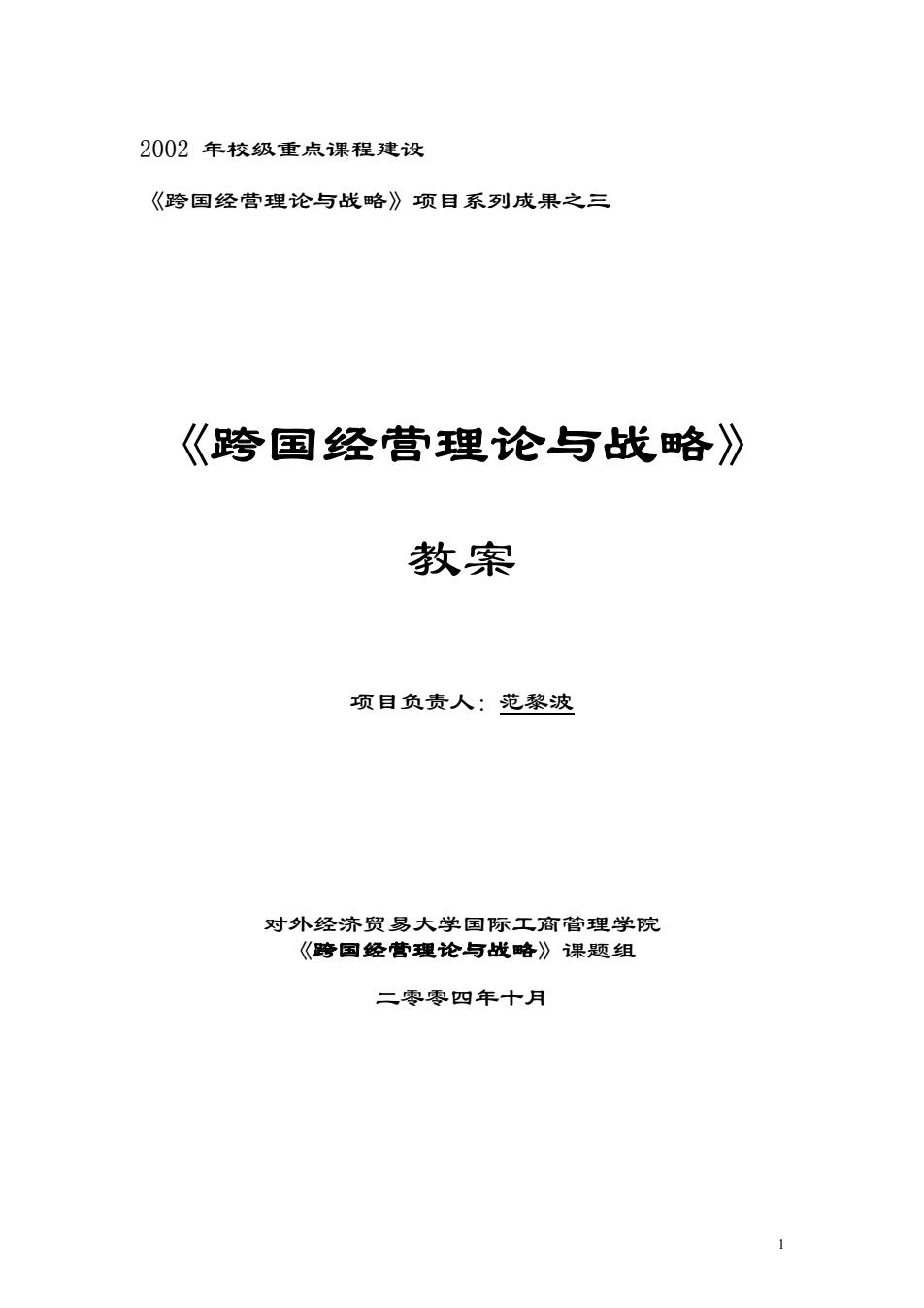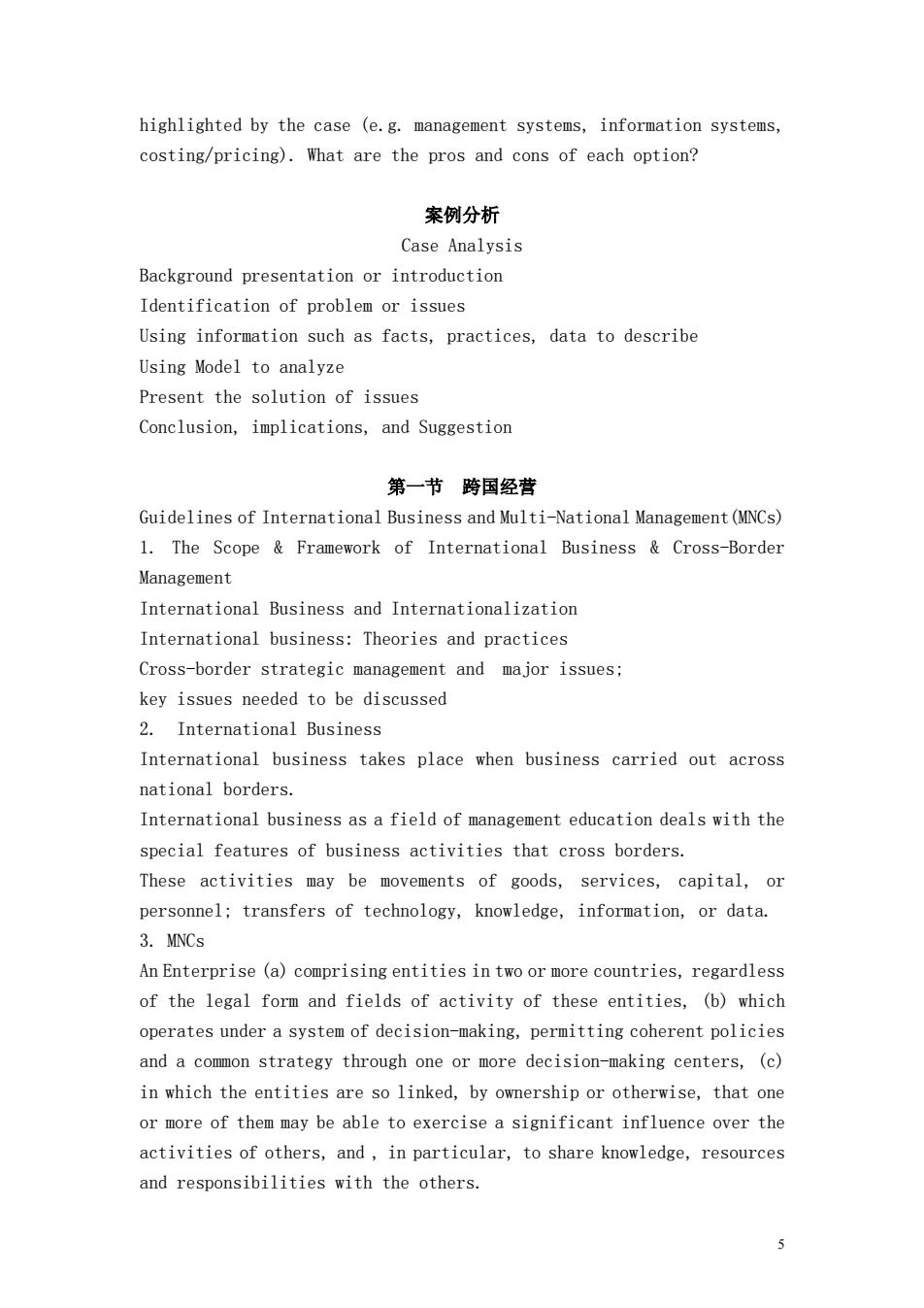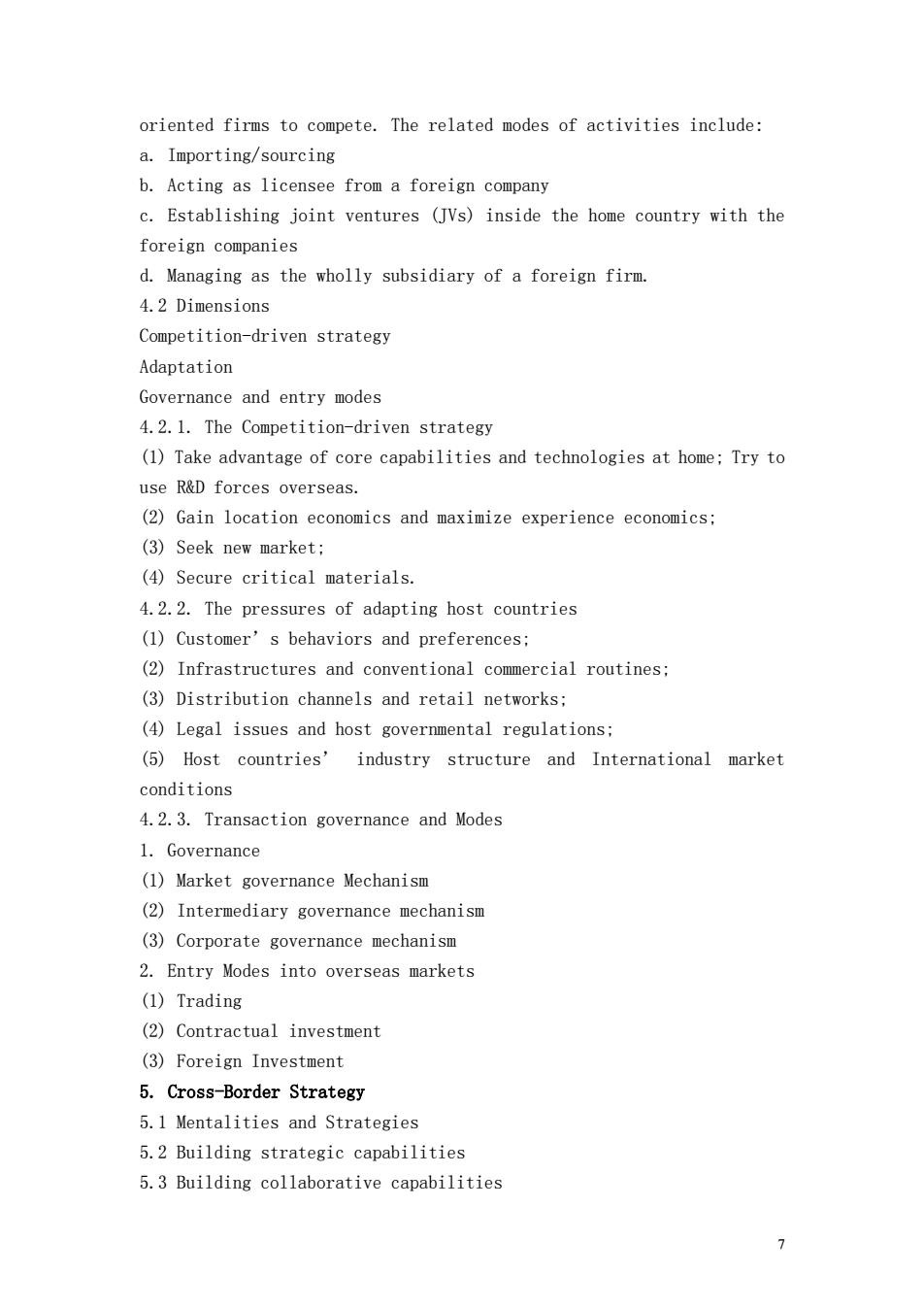
2002年校级重点课程建设 《跨国经营理论与战略》项目系列成果之三 《跨国经营理论与战略》 教案 项目负责人:范黎波 对外经济贸易大学国际工商管理学院 《跨国经营理论与战略》课题组 二零零四年十月
1 2002 年校级重点课程建设 《跨国经营理论与战略》项目系列成果之三 《跨国经营理论与战略》 教案 项目负责人:范黎波 对外经济贸易大学国际工商管理学院 《跨国经营理论与战略》课题组 二零零四年十月

目录 第一篇导论.… 3 第一章跨国公司与跨国经营.... …3 第二篇跨国经营理论…10 第二章基于贸易的跨国经营理论..................10 第三章基于外国直接投资(DI)的跨国经营理论....…13 第四章基于发展中国家和地区的跨国经营理论........15 第三篇跨国进入战略...... 19 第五章跨国进入分析.19 第六章跨国进入方式... ……….23 第四篇跨国经营战略篇.. 28 第七章获得全球竞争优势 29 第八章跨国企业营销战略...· 41 第九章跨国企业的资源寻求战略...46 第五篇走出去战略...... …….51 第十章中国企业跨国经营战略.」 51 2
2 目 录 第一篇 导论.........................................................3 第一章 跨国公司与跨国经营 .........................................3 第二篇 跨国经营理论................................................10 第二章 基于贸易的跨国经营理论 ....................................10 第三章 基于外国直接投资(FDI)的跨国经营理论 .....................13 第四章 基于发展中国家和地区的跨国经营理论 ........................15 第三篇 跨国进入战略................................................19 第五章 跨国进入分析 ..............................................19 第六章 跨国进入方式 ..............................................23 第四篇 跨国经营战略篇.............................................28 第七章 获得全球竞争优势 .........................................29 第八章 跨国企业营销战略 ..........................................41 第九章 跨国企业的资源寻求战略 ...................................46 第五篇 走出去战略..................................................51 第十章 中国企业跨国经营战略 ......................................51

第一篇导论 第一章跨国公司与跨国经营 【教学目的和要求】 1、了解本课程的框架教学时数:1 2、跨国公司的定义与概念发展教学时数:1 3、了解跨国公司所处的外部环境与面临的挑战 教学时数:1 【基础知识】 1、跨国公司定义 2、跨国经营的概念与发展 3、全球化的内涵 教学总时数:3 参考资料:《跨国经营理论与战略》第一章后参考文献 作业与练习:阅读《跨国管理》Readings1一1,1一2 案例讨论1:INGVARKAMPRAD AND IKEA 教学时数:2 Objectives .The case contributes to learning at three broad levels: 1.The strategic level 2.The organizational level 3.The managerial level Subject and assignment questions 1.Subject:IKEA strategy in Sweden/Questions:What were the sources of IKEA's successful entry in furniture retailing business in Sweden? 2.Subject:IKEA's strategy while expanding internationally/Questions: How important was internationalization to IKEA?What challenges did IKEA face while expanding internationally,and how did it overcome them? 3 Subject:Organizational capabilities of IKEA/Questions:What were the management processes by which IKEA coordinated and controlled its Euro-wide operations?How effective were they? 4.Subject:Organizational value and Ingwar Kamprad's vision/Questions: What were Ingvar's role in IKEA's development? 5.Subject:Action plan for the future/Questions:What challenges lie ahead for IKEA?Please recommend what course of action Anders Moberg should follow in order to deal with them? 3
3 第一篇 导论 第一章 跨国公司与跨国经营 【教学目的和要求】 1、了解本课程的框架 教学时数:1 2、跨国公司的定义与概念发展 教学时数:1 3、了解跨国公司所处的外部环境与面临的挑战 教学时数:1 【基础知识】 1、跨国公司定义 2、跨国经营的概念与发展 3、全球化的内涵 教学总时数:3 参考资料:《跨国经营理论与战略》第一章后参考文献 作业与练习:阅读《跨国管理》Readings 1-1,1-2 案例讨论 1:INGVARKAMPRAD AND IKEA 教学时数:2 Objectives •Thecasecontributestolearningatthreebroadlevels: 1. The strategic level 2. The organizational level 3. The managerial level Subject and assignment questions 1. Subject: IKEA strategy in Sweden/ Questions: What were the sources of IKEA’s successful entry in furniture retailing business in Sweden? 2.Subject: IKEA’s strategy while expanding internationally/ Questions: How important was internationalization to IKEA? What challenges did IKEA face while expanding internationally, and how did it overcome them? 3 Subject: Organizational capabilities of IKEA/ Questions: What were the management processes by which IKEA coordinated and controlled its Euro-wide operations? How effective were they? 4. Subject: Organizational value and Ingwar Kamprad’s vision/ Questions: What were Ingvar’s role in IKEA’s development? 5. Subject: Action plan for the future/ Questions: What challenges lie ahead for IKEA? Please recommend what course of action Anders Moberg should follow in order to deal with them?

学习思路 国际化、规范化、本土化 国际化是指熟悉国际经济政治和跨国公司: 规范化是指学习规范的理论和研究方法。什么是规范化研究,主要包括:(1)实证 (positive)研究:主要要是基于对现实的解释、说明从而预测将来;(2)规范 (normative),研究:主要是设计将来应该应该如何,怎么样做才是最佳的。两者 结合:光解释和预测是不够的,还必须说明什么人是好的选择。 本土化是指了解现实的困惑问题和尝试提出解决方案。 案例研究 案例定义:Case definition Cases and exercises are not the same thing. A case is a:A resource for group discussion.Whose purpose is to help people to acquire the aptitude to: Think Discuss Exchange points of view 案例的组分 Outline of A Typical Case Here is a typical outline of the information which a case will cover.Of course,this outline can differ from one case to another. (1)The Issue:Description of the problem at hand (2)The Character(s):Description of person(s)in charge,such as time spent in the company,executive(s)to whom he/she reports,etc. (3)The Company:Background of the company and the business unit concerned, including history,key numbers,organizational structure,geographic scope,corporate philosophy,products,etc. Continue to the last page (4)The Industry:Size (domestically,world wide,or in countries concerned),key trends (technical,social,economic,political), customer groups,competition,products and markets,strategies and key success factors,etc. (5)The Options:What are the different options to solved the issue
4 学习思路 国际化、规范化、本土化 国际化是指熟悉国际经济政治和跨国公司; 规范化是指学习规范的理论和研究方法。什么是规范化研究,主要包括:(1)实证 (positive)研究:主要要是基于对现实的解释、说明从而预测将来;(2)规范 (normative)研究:主要是设计将来应该应该如何,怎么样做才是最佳的。两者 结合:光解释和预测是不够的,还必须说明什么人是好的选择。 本土化是指了解现实的困惑问题和尝试提出解决方案。 案例研究 案例定义:Case definition Cases and exercises are not the same thing. A case is a: A resource for group discussion. Whose purpose is to help people to acquire the aptitude to: Think Discuss Exchange points of view 案例的组分 Outline of A Typical Case Here is a typical outline of the information which a case will cover. Of course, this outline can differ from one case to another. (1) The Issue: Description of the problem at hand (2) The Character(s): Description of person(s) in charge, such as time spent in the company, executive(s) to whom he/she reports, etc. (3) The Company: Background of the company and the business unit concerned, including history, key numbers, organizational structure, geographic scope, corporate philosophy, products, etc. Continue to the last page (4) The Industry: Size (domestically, world wide, or in countries concerned), key trends (technical, social, economic, political), customer groups, competition, products and markets, strategies and key success factors, etc. (5) The Options: What are the different options to solved the issue

highlighted by the case (e.g.management systems,information systems, costing/pricing).What are the pros and cons of each option? 案例分析 Case Analysis Background presentation or introduction Identification of problem or issues Using information such as facts,practices,data to describe Using Model to analyze Present the solution of issues Conclusion,implications,and Suggestion 第一节跨国经营 Guidelines of International Business and Multi-National Management(MNCs) 1.The Scope Framework of International Business Cross-Border Management International Business and Internationalization International business:Theories and practices Cross-border strategic management and major issues; key issues needed to be discussed 2.International Business International business takes place when business carried out across national borders. International business as a field of management education deals with the special features of business activities that cross borders. These activities may be movements of goods,services,capital,or personnel;transfers of technology,knowledge,information,or data. 3.MNCs An Enterprise (a)comprising entities in two or more countries,regardless of the legal form and fields of activity of these entities,(b)which operates under a system of decision-making,permitting coherent policies and a common strategy through one or more decision-making centers,(c) in which the entities are so linked,by ownership or otherwise,that one or more of them may be able to exercise a significant influence over the activities of others,and,in particular,to share knowledge,resources and responsibilities with the others. 5
5 highlighted by the case (e.g. management systems, information systems, costing/pricing). What are the pros and cons of each option? 案例分析 Case Analysis Background presentation or introduction Identification of problem or issues Using information such as facts, practices, data to describe Using Model to analyze Present the solution of issues Conclusion, implications, and Suggestion 第一节 跨国经营 Guidelines of International Business and Multi-National Management(MNCs) 1. The Scope & Framework of International Business & Cross-Border Management International Business and Internationalization International business: Theories and practices Cross-border strategic management and major issues; key issues needed to be discussed 2. International Business International business takes place when business carried out across national borders. International business as a field of management education deals with the special features of business activities that cross borders. These activities may be movements of goods, services, capital, or personnel; transfers of technology, knowledge, information, or data. 3. MNCs An Enterprise (a) comprising entities in two or more countries, regardless of the legal form and fields of activity of these entities, (b) which operates under a system of decision-making, permitting coherent policies and a common strategy through one or more decision-making centers, (c) in which the entities are so linked, by ownership or otherwise, that one or more of them may be able to exercise a significant influence over the activities of others, and , in particular, to share knowledge, resources and responsibilities with the others

In essence,this definition pays more attention on the importance of strategic and organizational integration and,thereby,management integration of operations located in different countries is regarded as the key differentiating characteristic of an MNC. What really differentiates the MNC is that it creates an internal organization to carry out key cross-border tasks and transactions internally rather than depending on trade through the open markets. 1.Structural Criterion (1)Operations location (2)Value activities'Facilities and relationship (3)Ownership 2.Transnationality 3.Attitude toward international business (ethnocentric,polycentric, and geocentric) 4.Internationalization Internationalization is the process by which firms increase their awareness of the influence of international activities on their future, and establish and conduct transactions with firms from other countries. 4.1 Perspective:Out-war In-ward-Looking Internationalization has both inward looking and outward looking dimension. The outward-looking perspective incorporates an awareness of the nature of competition in foreign markets,and includes the following modes of activities: a.Exporting B.Acting as licensor to a foreign company c.Establishing joint ventures outside the home country with foreign companies d.Establishing or acquiring wholly-owned businesses outside the home country Internationalization affects firms in equal important ways from an inward-looking perspective,which incorporates an awareness of the impact of Multinational Corporations (MNCs)on the ability of domestically 6
6 In essence, this definition pays more attention on the importance of strategic and organizational integration and, thereby, management integration of operations located in different countries is regarded as the key differentiating characteristic of an MNC. What really differentiates the MNC is that it creates an internal organization to carry out key cross-border tasks and transactions internally rather than depending on trade through the open markets. 1. Structural Criterion (1) Operations location (2) Value activities’ Facilities and relationship (3) Ownership 2. Transnationality 3. Attitude toward international business (ethnocentric, polycentric, and geocentric) 4. Internationalization Internationalization is the process by which firms increase their awareness of the influence of international activities on their future, and establish and conduct transactions with firms from other countries. 4.1 Perspective: Out-war & In-ward-Looking Internationalization has both inward looking and outward looking dimension. The outward-looking perspective incorporates an awareness of the nature of competition in foreign markets, and includes the following modes of activities: a. Exporting B. Acting as licensor to a foreign company c. Establishing joint ventures outside the home country with foreign companies d. Establishing or acquiring wholly-owned businesses outside the home country Internationalization affects firms in equal important ways from an inward-looking perspective, which incorporates an awareness of the impact of Multinational Corporations (MNCs) on the ability of domestically

oriented firms to compete.The related modes of activities include: a.Importing/sourcing b.Acting as licensee from a foreign company c.Establishing joint ventures (JVs)inside the home country with the foreign companies d.Managing as the wholly subsidiary of a foreign firm. 4.2 Dimensions Competition-driven strategy Adaptation Governance and entry modes 4.2.1.The Competition-driven strategy (1)Take advantage of core capabilities and technologies at home;Try to use R&D forces overseas. (2)Gain location economics and maximize experience economics: (3)Seek new market; (4)Secure critical materials. 4.2.2.The pressures of adapting host countries (1)Customer's behaviors and preferences; (2)Infrastructures and conventional commercial routines: (3)Distribution channels and retail networks; (4)Legal issues and host governmental regulations; (5)Host countries'industry structure and International market conditions 4.2.3.Transaction governance and Modes 1.Governance (1)Market governance Mechanism (2)Intermediary governance mechanism (3)Corporate governance mechanism 2.Entry Modes into overseas markets (1)Trading (2)Contractual investment (3)Foreign Investment 5.Cross-Border Strategy 5.1 Mentalities and Strategies 5.2 Building strategic capabilities 5.3 Building collaborative capabilities
7 oriented firms to compete. The related modes of activities include: a. Importing/sourcing b. Acting as licensee from a foreign company c. Establishing joint ventures (JVs) inside the home country with the foreign companies d. Managing as the wholly subsidiary of a foreign firm. 4.2 Dimensions Competition-driven strategy Adaptation Governance and entry modes 4.2.1. The Competition-driven strategy (1) Take advantage of core capabilities and technologies at home; Try to use R&D forces overseas. (2) Gain location economics and maximize experience economics; (3) Seek new market; (4) Secure critical materials. 4.2.2. The pressures of adapting host countries (1) Customer’s behaviors and preferences; (2) Infrastructures and conventional commercial routines; (3) Distribution channels and retail networks; (4) Legal issues and host governmental regulations; (5) Host countries’ industry structure and International market conditions 4.2.3. Transaction governance and Modes 1. Governance (1) Market governance Mechanism (2) Intermediary governance mechanism (3) Corporate governance mechanism 2. Entry Modes into overseas markets (1) Trading (2) Contractual investment (3) Foreign Investment 5. Cross-Border Strategy 5.1 Mentalities and Strategies 5.2 Building strategic capabilities 5.3 Building collaborative capabilities

5.4 Developing coordination and control 5.5 Creating and leveraging world-wide knowledge 5.1 Mentalities and strategies International strategy Multinational strategy Global strategy Transnational strategy 5.2 Building strategic capabilities 1.Goals 2.Means 5.3 Building collaborative capabilities 1.Why strategic alliances? 2.The risks and costs of Collaboration 3.Building and managing collaborative ventures 5.4 Developing coordination and control 1.Administrative heritage (1)Decentralized federation (2)Coordinated federation (3)Centralized hub 2.Anatomy,Physiology,and Psychology (1)Structuring the orga.'s anatomy (2)Building the org.'s physiology (3)Developing the org.'s Psychology 3.Managing the change process 5.5 Creating and leveraging world-wide knowledge Building multiple innovative processes: 1.Making central innovations effective 2.Making local innovation efficient 3.Making transnational process feasible
8 5.4 Developing coordination and control 5.5 Creating and leveraging world-wide knowledge 5.1 Mentalities and strategies International strategy Multinational strategy Global strategy Transnational strategy 5.2 Building strategic capabilities 1. Goals 2. Means 5.3 Building collaborative capabilities 1. Why strategic alliances? 2. The risks and costs of Collaboration 3. Building and managing collaborative ventures 5.4 Developing coordination and control 1. Administrative heritage (1) Decentralized federation (2) Coordinated federation (3) Centralized hub 2. Anatomy, Physiology, and Psychology (1) Structuring the orga.’s anatomy (2) Building the org.’s physiology (3) Developing the org.’s Psychology 3. Managing the change process 5.5 Creating and leveraging world-wide knowledge Building multiple innovative processes: 1. Making central innovations effective 2. Making local innovation efficient 3. Making transnational process feasible

第二节全球化挑战 全球化的内涵 全球统一市场 全球市场新规则 FDI特征 中国外贸和利用外资 中国进出口贸易总额:(亿美元) 我国实际使用外国直接投资情况汇总表 第三节跨国经营与跨国企业所面临的挑战 传统的补救措施与新问题(0ld remedies and new problems) 全球竞争的不连续性(Competitive discontinuity)对跨国公司的挑战 跨国公司面临的内部挑战:转变内部治理方式(Transforming Internal Governance) 竞争的不连续性(Competitive discontinuity) 1.消费市场发生重大变化(Prosumerism) 2.行业自由化、私有化和全球化(Deregulation,privatization,and globalization) 3.中间环节在消失(Disintermediation) 4.技术进步与数字化(Digital convergence) 不确定的竞争局面(Indeterminate competitive landscape) 6.激烈的标准竞争和日趋标准公开(Evolution to open standards) 7.产品生命周期越来越短 8.生态与社会的敏感性(Ecological and social sensibility) 转变内部治理方式 (1)更加主动地面向市场竞争 (2)始终关注未来 (3)重视中层管理力量在战略制定中作用 (4)发展战略联盟关系 (5)重视人和事之间的分离性 跨国经营的概念和历史发展 跨国经营的起源(1600-1914) 两次世界大战期间的跨国经营(1914-1945) 第二次世界大战后的跨国经营(1945-1980) 20世纪80年代后的跨国经营(1980至今)
9 第二节 全球化挑战 全球化的内涵 全球统一市场 全球市场新规则 FDI 特征 中国外贸和利用外资 中国进出口贸易总额:(亿美元) 我国实际使用外国直接投资情况汇总表 第三节 跨国经营与 跨国企业所面临的挑战 传统的补救措施与新问题 (Old remedies and new problems) 全球竞争的不连续性(Competitive discontinuity)对跨国公司的挑战 跨国公司面临的内部挑战:转变内部治理方式(Transforming Internal Governance) 竞争的不连续性(Competitive discontinuity) 1.消费市场发生重大变化(Prosumerism) 2 . 行 业 自 由 化 、 私 有 化 和 全 球 化 ( Deregulation, privatization, and globalization) 3.中间环节在消失(Disintermediation) 4.技术进步与数字化(Digital convergence) 不确定的竞争局面(Indeterminate competitive landscape) 6.激烈的标准竞争和日趋标准公开(Evolution to open standards) 7.产品生命周期越来越短 8.生态与社会的敏感性(Ecological and social sensibility) 转变内部治理方式 (1)更加主动地面向市场竞争 (2)始终关注未来 (3)重视中层管理力量在战略制定中作用 (4)发展战略联盟关系 (5)重视人和事之间的分离性 跨国经营的概念和历史发展 跨国经营的起源(1600-1914) 两次世界大战期间的跨国经营(1914-1945) 第二次世界大战后的跨国经营(1945-1980) 20 世纪 80 年代后的跨国经营(1980 至今)

思考题: (1)跨国经营和全球化的区别。 (2)如何理解跨国企业面临的双重挑战? Part Two International Business Theories and Practices 第二篇跨国经营理论 本篇包含有三个章节: 基于贸易的跨国经营理论 基于外国直接投资的跨国经营理论 基于发展中国家和地区的跨国经营理论 Categories of Theories 1.International trade theories 2.Industrial Organizational Theories 3.Theories on developing countries 4.The geo-business model 第二章基于贸易的跨国经营理论 贸易结构理论 产品生命周期理论 小岛清的边际产业理论 国家竞争优势理论 【教学目的和要求】 理解和掌握贸易结构优化理论 教学时数:1 理解和掌握产品生命周期理论 教学时数:0.5 理解和掌握边际产业理论 教学时数:0.5 理解和掌握国家竞争优势理论教学时数:1 【基础知识】 贸易结构优化理论 产品生命周期理论 边际产业理论 10
10 思考题: (1)跨国经营和全球化的区别。 (2)如何理解跨国企业面临的双重挑战? Part Two International Business Theories and Practices 第二篇 跨国经营理论 本篇包含有三个章节: 基于贸易的跨国经营理论 基于外国直接投资的跨国经营理论 基于发展中国家和地区的跨国经营理论 Categories of Theories 1. International trade theories 2. Industrial Organizational Theories 3. Theories on developing countries 4. The geo-business model 第二章 基于贸易的跨国经营理论 贸易结构理论 产品生命周期理论 小岛清的边际产业理论 国家竞争优势理论 【教学目的和要求】 理解和掌握贸易结构优化理论 教学时数:1 理解和掌握产品生命周期理论 教学时数:0.5 理解和掌握边际产业理论 教学时数:0.5 理解和掌握国家竞争优势理论 教学时数:1 【基础知识】 贸易结构优化理论 产品生命周期理论 边际产业理论